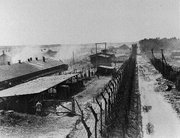Bergen-Belsen
|
|
| Contents |
History
It was started in 1940 as a POW camp. Until spring 1942, about 18,000 Soviet soldiers had died of hunger, cold and disease. Later (1942) Bergen-Belsen became a concentration camp; the SS took command of it in April 1943. In March 1944 the camp was redesignated as an "Ehrholungslager" (= "Recovery Camp"), [1] (http://www.jewishvirtuallibrary.org/jsource/Holocaust/Belsen.html) where prisoners of other camps too sick to work were brought. It is usually said that there were no gas chambers in Bergen-Belsen, since the mass executions took place in the camps further east (but see below); nevertheless thousands of Jews, Czechs, Poles, anti-Nazi Christians, homosexuals, and Roma and Sinti died in the camp. In 1945 the prisoners of other camps were brought to the front lines, since these camps were liberated by the Soviets. In overcrowded conditions disease and malnutrition caused many deaths. Mass graves were dug. Eventually, 34 female guards served at Bergen-Belsen, many of them escaping as the British neared. Prisoners said after the war that they saw SS men and women burning papers and fleeing the camp days before the troops arrived. The SS who stayed, however, wore white armbands.
Liberation and after
When the British advanced near the camp in 1945, the German army negotiated an exclusion zone around the camp to prevent the spread of typhus. Hungarian and regular German troops guarding the camp would be returned to German lines after the battle, but this did not extend to the SS. When the British liberated the camp on April 15, 1945, they found thousands of bodies unburied; they forced the remaining SS personnel to bury these, and ordered local German civilians to assist. The living prisoners were moved to a nearly German Panzer army camp. Bergen-Belsen was then burned to the ground by flamethrowers mounted on tanks because of the infestation of epidemic typhus and lice. If an account of events mentions Belsen as still inhabited weeks or months after liberation, it means that Panzer camp.
There is an account that, before the main liberation, some British troops passed the camp while following orders to reach the Baltic Sea before the Russians could reach the North Sea; the troops ordered the camp authorities to behave correctly from then on, and left; but there were hundreds more executions there before the main liberation.
Many of the former SS staff that survived the typhus epidemic were tried by the British at the Belsen Trial. One defendant, Klara Opitz, lost all of her hair from the disease. At the trial, the world got its first view of Irma Grese, Elizabeth Volkenrath, Juana Bormann, Fritz Klein, Josef Kramer and the rest of the SS men and SS women who before served at Mittelbau Dora, Ravensbruck, Auschwitz I, II, III, and Neuengamme. Many of the female guards in fact served at tiny Gross Rosen subcamps at Neusalz, Langenleuba, and the Dora Mittelbau (Mittelbau Dora) subcamp at Gross Werther.
At least 50,000 people died in Bergen-Belsen before liberation, among them Anne Frank and her sister Margot, who died there in March 1945. An estimated 13,000 more died of illness and malnutrition shortly after liberation. Although the camp was burned to the ground, the site is today open to the public, featuring a visitors' centre, a monument to the dead, [2] (http://diaspora.org.il/chamber%20/belsen.htm) and a "House of Silence" for reflection.
There is an image of Anne Frank's memorial in this page's German version, which can be found by clicking on "Deutsch" in the left margin.
After the war, the name "Belsen" became proverbial and emotive for skinnyness of humans and confinement in suffering, and was often re-applied metaphorically to various situations, often casually and inappropriately.
Was there a gas chamber at Belsen?
Most people say not. But this link (http://www.scrapbookpages.com/BergenBelsen/BergenBelsen04.html) quotes two witness accounts that say otherwise. These accounts are, in summary:-
- Moshe Peer. French Jew. Born in France in 1932 or 1933. Arrested in 1942 at age 9. Sent to Belsen 2 years later. 6 attempts to gas him failed because (unlike the other prisoners) he was immune or very resistant to whatever gas was used. An experience even more distressing than with most reports from there. After liberation he moved to Israel where he raised 4 children. He fought in various of Israel's wars. In 1974 he moved to Montreal in Canada.
- Niall Aslen. Son of a British soldier who liberated Belsen; information via his father. The gas chamber was underground. Liberating troops demolished the gas chamber and used the resulting open pit to bury bodies in.
References
- Bergen-Belsen Memorial (http://www.bergenbelsen.de/en/chronik/)
- The United States' Holocaust Memorial website on Belsen (http://www.ushmm.org/wlc/article.php?lang=en&ModuleId=10005258)
- A lengthy account of the site and its liberation (http://www.scrapbookpages.com/BergenBelsen/ConcentrationCamp.html)
External Links
- BBC Journalist Richard Dimbleby's original Radio Report from April 15. (http://news.bbc.co.uk/2/hi/in_depth/4445811.stm)
- Belsen 60 years on, BBC. (http://news.bbc.co.uk/1/hi/world/europe/4445529.stm)
- Belsen 60 years on, Daily Telegraph (http://www.telegraph.co.uk/news/main.jhtml?xml=/news/2005/04/18/wbels18.xml&sSheet=/news/2005/04/18/ixhome.html)
de:KZ Bergen-Belsen fr:Bergen-Belsen nl:Bergen-Belsen pl:Bergen-Belsen pt:Bergen-Belsen sv:Bergen-Belsen



